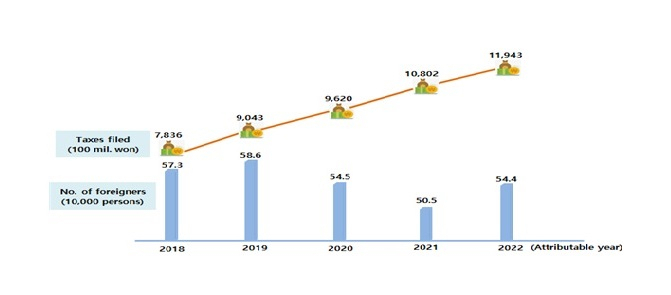 |
The line graph shows the total year-end taxes paid by foreign national workers in South Korea between 2018 and 2022, while the bar graph shows the number of foreign employees who submitted their year-end tax settlements over the same period. (National Tax Service) |
The total amount in year-end tax settlements submitted by employees of foreign nationality in South Korea reached a record high of 1.19 trillion won ($910 million) last year, the National Tax Service said Wednesday.
All wage-earning workers of foreign nationality here, except for day laborers, are required to file their year-end tax settlements, as are those of Korean nationality.
Foreign national taxpayers who submitted year-end tax settlements for income attributable to the year 2022 totaled 544,000 people last year, up from 505,000 in 2021. The number had been on the rise since 2017, but dropped in 2020 and 2021, likely due to the impact of the COVID-19 pandemic, the tax agency said.
The total amount in year-end tax settlements submitted by Korea's foreign national employees has drawn a constant upward graph over the past five years from 770.7 billion won in 2017 to 1.194 trillion won in 2022.
Marking the month of year-end tax settlements in January, the tax agency also encouraged foreign workers to file their year-end taxes for 2023’s income.
Settlements should be submitted no later than the date on which wages for February this year are paid. If workers do not receive their salary for February within that month, or if they do not have income for February, then the due date is the last day of February.
Most of the details, including the method, tax credit items and filing procedures, are identical or nearly so to those for Korean nationals, except for a few special regulations such as a flat 19 percent tax rate and income tax breaks for engineers.
In the case of the 19 percent flat rate, the period during which it is applicable has been extended from five to 20 years, starting this year, enabling those who have worked for a long time in Korea to choose this flat rate.
Income tax cuts for foreign engineers can now be applied for up to 10 years, instead of the previous five, from when an engineer first started working here.
Foreign workers, however, are not eligible for deductions of savings to buy a home, as they do not technically meet the qualifications to be considered a “head of the household” under the Resident Registration Act.
More detailed information can be found in the English guidebook, "Easy Guide," and English, Chinese and Vietnamese manuals provided on the agency's English website. A short instructional video is also available in the three languages on the NTS' official YouTube channel.
Foreign employees with questions can reach the NTS English hotline at 1588-0560.
Meanwhile, among the 544,000 employees of foreign nationality who filed year-end taxes last year, Chinese nationals accounted for the largest portion at 34.5 percent, followed by Vietnamese at 8.2 percent, Nepalese at 6.2 percent, Indonesians at 5.1 percent and Americans at 4.9 percent.
In terms of the portions filed, Americans accounted for 40 percent of the total taxes paid, followed by Chinese with 13.6 percent, Japanese with 6 percent, Canadians with 5.8 percent and Australians with 2.7 percent.




![[Weekender] Korea's traditional sauce culture gains global recognition](http://res.heraldm.com/phpwas/restmb_idxmake.php?idx=644&simg=/content/image/2024/11/21/20241121050153_0.jpg)


